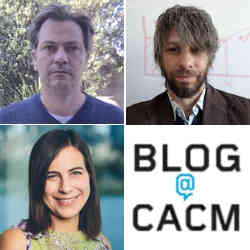
We organized a semester virtual institute in the academic metaverse with researchers from around the world. This format has great potential, but there are still opportunities for improvement.
Research advances faster when researchers with complementary expertise are able to interact closely for extended periods of time. This premise motivates semester-long in-person programs at institutes like the Simons Institute, IPAM, MSRI, etc. The pandemic has led to the development of mainstream meeting technology for research meetings and seminars (e.g., Zoom) and conferences (e.g., Hopin, Whova). However, these technologies miss a critical aspect important for research advances: frequent unplanned interactions over a long period of time. These unplanned interactions are important as novel research connections and research directions are more likely to originate from discussions between “weak tie” researchers (Granovetter, 1973). In-person special programs, though valuable, are also costly and disruptive, and participation is limited to those who are able to relocate for the duration of the program. Can similar results be had from a virtual program on a meeting technology that emphasizes unplanned interactions?
In the Fall of 2021, we participated in a Virtual Institute on Prophet Inequalities led by Jose Correa of Universidad de Chile. (Prophet inequalities is an area of stochastic optimization from optimal stopping theory that has been very influential in research at the interface between theoretical computer science and microeconomics.) The virtual institute took place on a virtual meeting platform provided by Virtual Chair and powered by Gather.town. The venue had desks for the participants, a seminar room for presentations, and meeting rooms for research conversations. Participants controlled avatars and walked around the venue joining presentations, meetings, and conversations as they would an in-person venue. Leveraging the flexibility of the platform and institute format, participants organically formed working groups around open problems. These interactions resulted in several forthcoming research papers. Virtual Chair now has an open call for proposals for similar institutes for 2022.
The remainder of this blog post aims to summarize how the semester went, and to discuss what went well and what could be improved.
Organizational Details
The institute convened weekly on Wednesdays from 8am to 12pm Eastern. It was attended regularly by 14 senior participants and about the same number of Ph.D. students and postdocs. In the kickoff session, many of the senior participants presented open problems. During subsequent sessions, there was a presentation by one of the senior participants at 9am and open time for research in groups during the remaining time. Participants were encouraged to hangout at their desks while not in otherwise scheduled meetings to simulate the “open door” of an in-person institute.
The virtual institute was run entirely on spatial chat. The platform was provided by Virtual Chair (and built on top of Gather.town). Spatial chat is based on the paradigm of walking an avatar around a two-dimensional map (see Figure 1) with video calls initiated between participants whose avatars are close together. The platform has native support for presentations which was used for the 9am seminar.
What worked and what could be improved
Overall the semester went very well. We, the organizers, were very happy with it and, as indicated in survey results, the participants were as well (see their feedback in the next section).
The space worked nicely. All core participants had their desks assigned in the virtual space. Also in the space were several meeting rooms, a lounge, a whiteboard area, a bulletin board, a bunch of student offices, and, of course, a seminar room. In addition to the basic functionality of spatial chat, you can share screen, use private spaces, stand in a podium to talk to the whole room or whole space, use text chat, and post links in a bulletin board, etc. Overall this made the interaction fluid. The Virtual Chair staff, particularly Maren St. Laurent, designed the space to facilitate fluid interaction and helped make everything run smoothly. (Thanks Maren!)
There were regular meetings of research groups in the hours before and after the 9am presentation with roughly 20 people on the platform. During the 9am presentation the attendance was around 30 people. There were at least five working groups and all of them are continuing with the aim of publishing their results.
The timing of the session (8am-12pm Eastern with a 9am seminar) was a compromise to accommodate the geographically dispersed participant list. Senior participants were joining from Tel Aviv to Texas. We would have preferred to split the formal presentation into two shorter presentations, one at the beginning and one at the end, to better mark the beginning and end of each session. For the chosen format, many participants were present for the seminar and a group meeting, but not the full four hours of the session. Thus, while the institute was already significantly more engaging than a typical virtual seminar, we think there is potential for even more engagement. The key challenges are coordinating schedules so that participants can attend together, and convincing them to do so.
Participant Feedback
In an end-of-semester survey, which had responses from about half of the senior participants and students, all respondents indicated an interest in participating in such programs in the future. Responses varied from desiring multiple per term to one per year with half the respondents indicating interest in one per term (see figure). All of the respondents attended the weekly seminar and over half of them participated in research meetings outside the seminar.
Some quotes from respondents, including recommendations on the format:
- “Super cool idea! As I started my Ph.D. just shortly before the pandemic, this was kind of a perfect way to get in touch with people [who] are interested in similar topics from all around the world.” – Ph.D. student
- “I really appreciated the opportunity to meet with researchers and listen to talks in this online setting! It was a great experience.” – Ph.D. Student
- “I would have gotten more out of it if I could clear the full four hours every week, but I don’t think I can do that every year.” – Assistant Professor
- “I love the idea. Sometimes I was wondering whether it would have been better to not meet every week but have some break in between “to recover”. There was a tendency to start new collaborations, but I felt I had only little time for offline thinking.” – Tenured Professor
Platform Recommendations
The spatial chat platform on Virtual Chair generally worked very well. The following improvements to the platform would be nice [with commentary from Virtual Chair’s technical team]:
- Some cloud space to upload files. Participants had slides and other documents that they wanted to post for the rest of the group. This was a two-step process of posting the documents to another cloud platform and then linking the URL into the bulletin board. [Virtual Chair: Support for this feature is coming soon.]
- Being able to more easily share screen with an iPad or tablet. Many participants are used to using tablets in virtual collaboration on other meeting platforms and it would be nice to more easily incorporate that modality into Virtual Chair. [Virtual Chair: It is possible to use a shared whiteboard with a tablet. Just export the URL of the whiteboard to the tablet and use the tablet as usual.]
- It was difficult to present in full-screen mode and also see the audience and use the chat feature. [Virtual Chair: Because Virtual Chair runs in the browser it is not possible to do full-screen overlays like other meeting technology. Participants have been successful using full screen if they have a second display.]
- Some presenters wanted to run polls during their presentations. [Virtual Chair: Support for this feature is coming soon.]
- Many collaboration tools (whiteboards, Google Docs, etc.) could be integrated into the space, but others could not (Dropbox, Miro, Jamboard). [Virtual Chair: Only websites that allow iframing can be seamlessly integrated into the venue. Some websites disallow it for security reasons.]
References
Granovetter, M. S. (1973). The strength of weak ties. American journal of sociology, 78(6), 1360-1380.
José Correa is a professor of Operations Research in the Department of Industrial Engineering at Universidad de Chile. His research interests are in combinatorial optimization, game theory and mechanism design, with a recent focus in pricing and online decision making. Jason Hartline is a professor of computer science in the McCormick School of Engineering at Northwestern University and a cofounder of Virtual Chair. His research interests are in applying methods from approximation algorithms to economics. Nicole Immorlica is a senior principal researcher at the Microsoft Research New England Lab and a cofounder of Virtual Chair. Her research interests lie at the intersection of economics and theoretical computer science.





Join the Discussion (0)
Become a Member or Sign In to Post a Comment